FIAT TEMPRA 1988 Service And Repair Manual
Manufacturer: FIAT, Model Year: 1988, Model line: TEMPRA, Model: FIAT TEMPRA 1988Pages: 171, PDF Size: 18.05 MB
Page 101 of 171
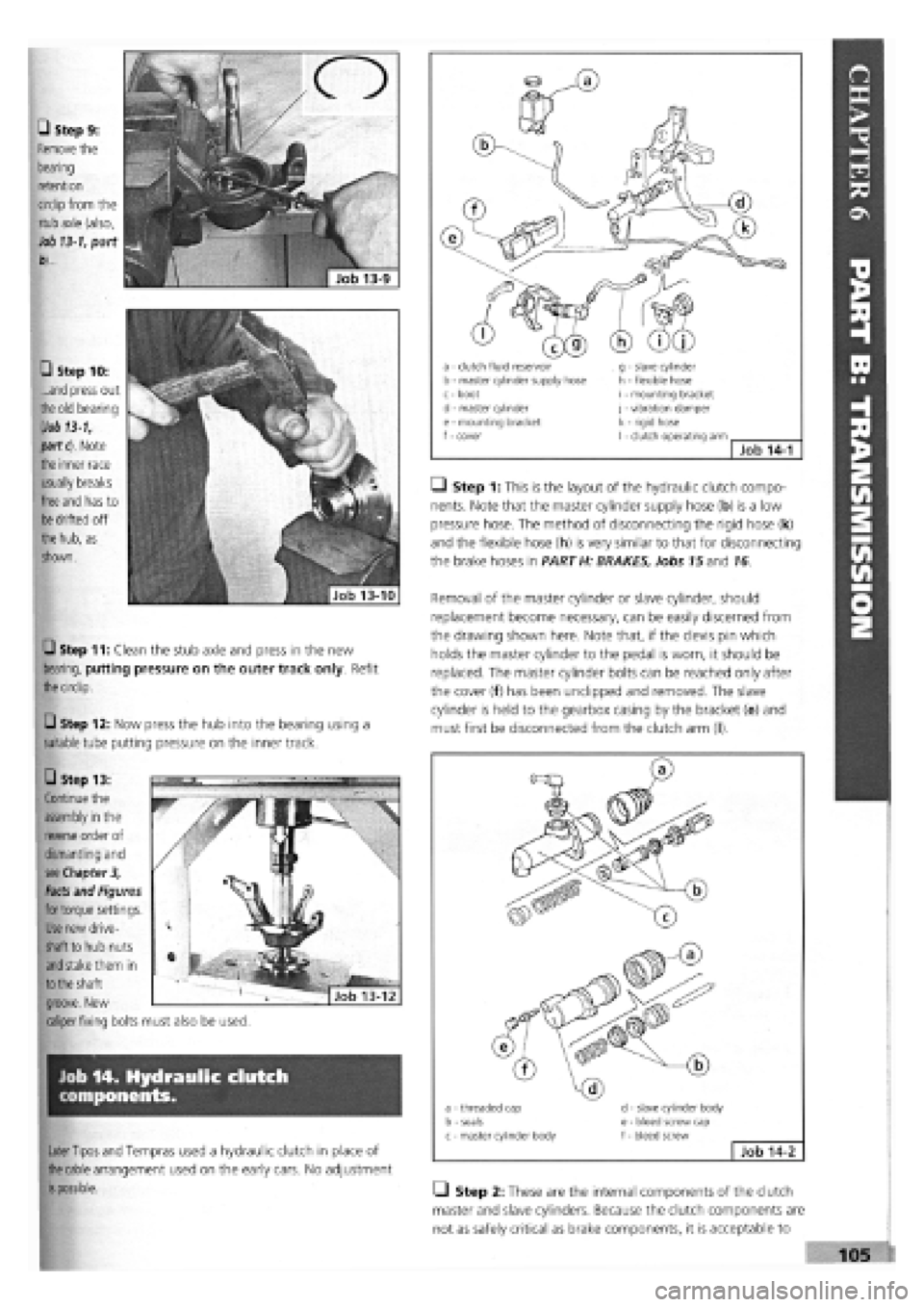
Job 14. Hydraulic clutch
components.
Later Tipos
and Tempras used a hydraulic clutch in place of
the cable
arrangement used on the early cars. No adjustment
is
possible.
a - clutch fluid reservoir b - master cylinder supply hose c - boot d - master cylinder e - mounting bracket f - cover
a
-
threaded cap b - seals c - master cylinder body
d - slave cylinder body e - bleed screw cap f - bleed screw
Job 14-2
g h i
i k
• Step 1: This is the layout of the hydraulic clutch compo-
nents. Note that the master cylinder supply hose (b) is a low
pressure hose. The method of disconnecting the rigid hose (k)
and the flexible hose (h) is very similar to that for disconnecting
the brake hoses in PART H: BRAKES, Jobs
15
and 16
Removal of the master cylinder or slave cylinder, should
replacement become necessary, can be easily discerned from
the drawing shown here. Note that, if the clevis pin which
holds the master cylinder to the pedal is worn, it should be
replaced. The master cylinder bolts can be reached only after
the cover (f) has been undipped and removed. The slave
cylinder is held to the gearbox casing by the bracket (e) and
must first be disconnected from the clutch arm (I).
• Step 2: These are the internal components of the clutch
master and slave cylinders. Because the clutch components are
not as safely critical as brake components, it is acceptable to
- mounting bracket - vibration damper - rigid hose - clutch operating arm Job 14-1
• Step 9:
Remove the
bearing
retention
cirdip from the
stub axle
(also,
Job 13-1, part
«...
- slave cylinder - flexible hose • Step 10:
...and press out
the old
bearing
{Job
13-1,
part c).
Note
the
inner race
usually breaks
free and
has to
be drifted
off
the hub,
as
shown.
Q Step 11: Clean the stub axle and press in the new
bearing, putting pressure on the outer track only. Refit
the
cirdip.
Q Step 12: Now press the hub into the bearing using a
suitable
tube putting pressure on the inner track.
• Step 13:
Continue the
assembly in the
reverse
order of
dismantling and
see
Chapter 3,
Facts
and Figures
for torque
settings.
Use
new drive-
shaft to
hub nuts
and stake
them in
to the
shaft
groove. New
caliper fixing
bolts must also be used.
Page 102 of 171
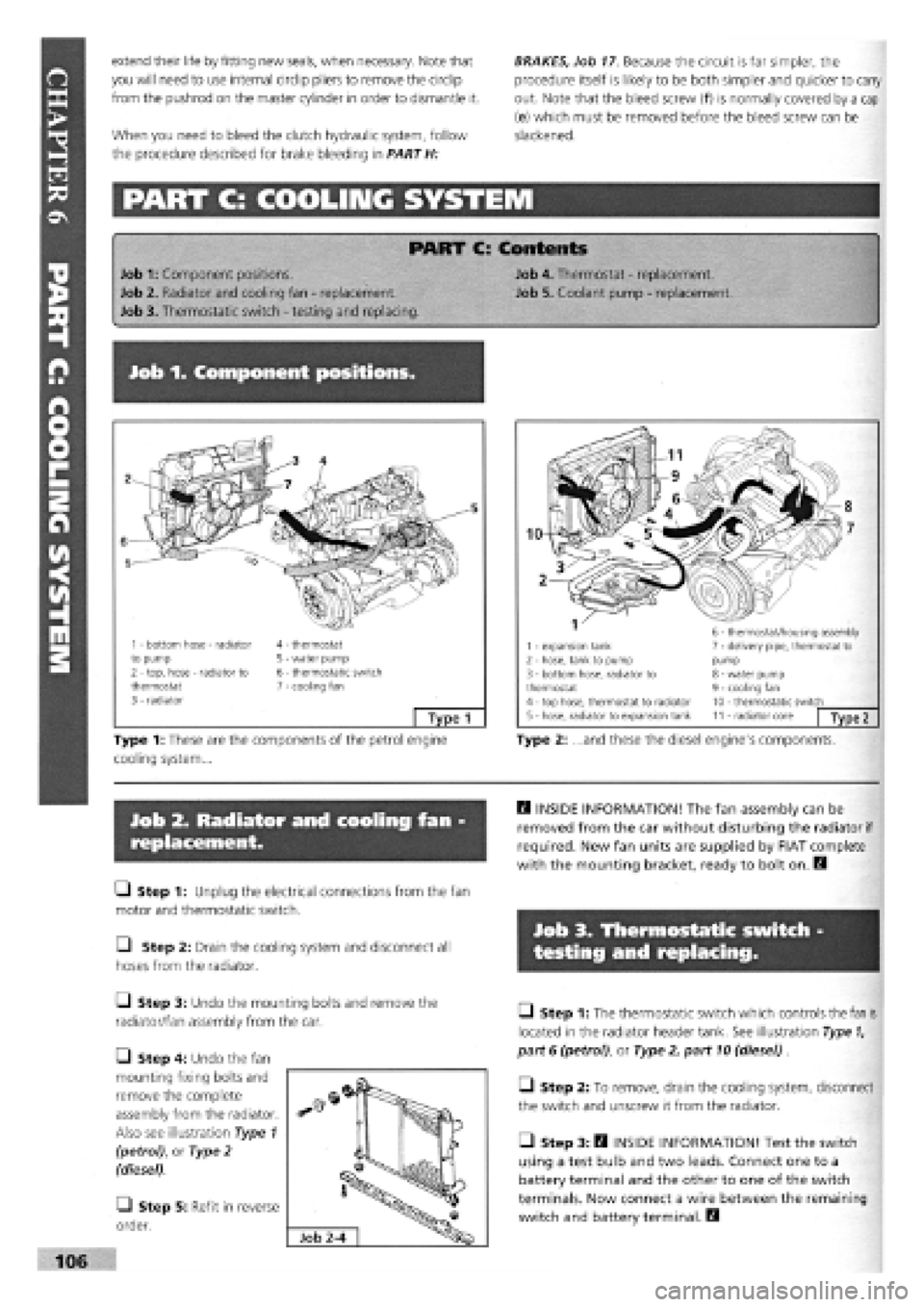
extend their life by fitting new seals, when necessary. Note that
you will need to use internal circlip pliers to remove the circlip
from the pushrod on the master cylinder in order to dismantle it.
When you need to bleed the clutch hydraulic system, follow
the procedure described for brake bleeding in PART H:
BRAKES, Job 17. Because the circuit is far simpler, the
procedure itself is likely to be both simpler and quicker to carry
out. Note that the bleed screw (f) is normally covered by a cap
(e) which must be removed before the bleed screw can be
slackened.
PART C: COOLING SYSTEM
PART C: Contents - ' B SI s |§w ^ - -
-
silt Job 1: Component positions. Job 4. Thermostat
-
replacement.
Job 2. Radiator and cooling fan
-
replacement. Job 5. Coolant pump
-
replacement.
Job 3. Thermostatic switch
-
testing and replacing.
Job 1. Component positions.
1 - bottom hose - radiator to pump 2 - top, hose - radiator to thermostat 3 - radiator
4 - thermostat 5
-
water pump 6 - thermostatic switch 7 - cooling fan
Type 1
1 - expansion tank 2 - hose, tank to pump 3 - bottom hose, radiator to thermostat 4 - top hose, thermostat to radiator 5 - hose, radiator to expansion tank
6 - thermostat/housing assembly 7 - delivery pipe, thermostat to pump 8
-
water pump 9 - cooling fan 10
-
thermostatic switch 11 - radiator core Type 2
Type 2: ...and these the diesel engine's components. Type 1: These are the components of the petrol engine
cooling system...
Job 2. Radiator and cooling fan -
replacement.
• Step 1: Unplug the electrical connections from the fan
motor and thermostatic switch.
• Step 2: Drain the cooling system and disconnect all
hoses from the radiator.
Q Step 3: Undo the mounting bolts and remove the
radiator/fan assembly from the car.
• Step 4: Undo the fan
mounting fixing bolts and
remove the complete
assembly from the radiator.
Also see illustration Type 1
(petrol), or Type 2
(diesel).
Q Step 5: Refit in reverse
order.
H INSIDE INFORMATION! The fan assembly can be
removed from the car without disturbing the radiator if
required. New fan units are supplied by FIAT complete
with the mounting bracket, ready to bolt on. D
Job 3. Thermostatic switch -
testing and replacing.
• Step 1: The thermostatic switch which controls the fan is
located in the radiator header tank. See illustration Type
1,
part 6 (petrol), or Type 2, part
10
(diesel) .
• Step 2: To remove, drain the cooling system, disconnect
the switch and unscrew it from the radiator.
• Step 3: H INSIDE INFORMATION! Test the switch
using a test bulb and two leads. Connect one to a
battery terminal and the other to one of the switch
terminals. Now connect a wire between the remaining
switch and battery terminal. (9
Page 103 of 171
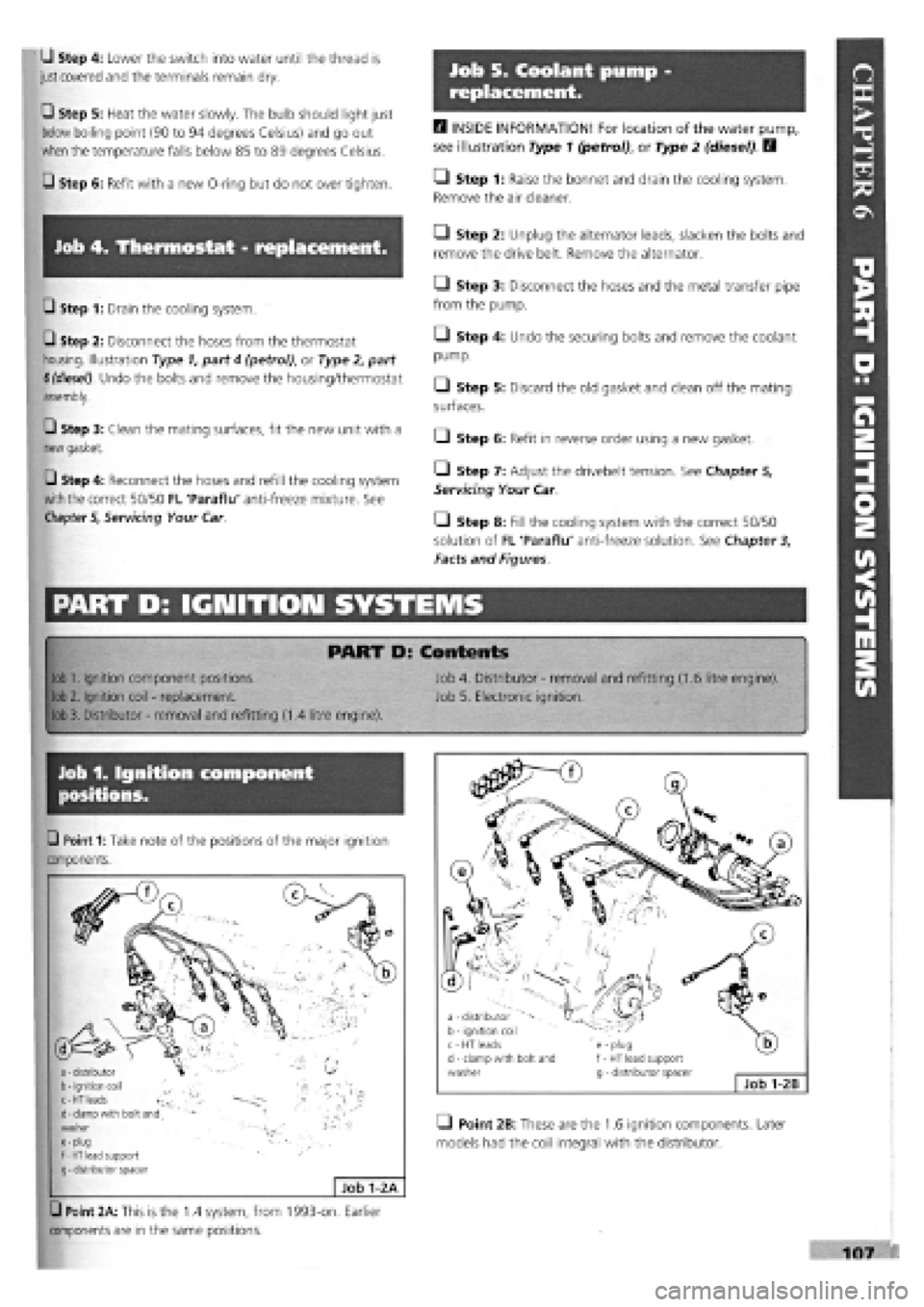
Job 5. Coolant pump -
replacement.
L) Step 4: Lower the switch into water until the thread is
just
covered and the terminals remain dry.
G Step 5: Heat the water slowly. The bulb should light just
below boiling point (90 to 94 degrees Celsius) and go out
when
the temperature falls below 85 to 89 degrees Celsius.
G Step 6: Refit with a new O-ring but do not over tighten.
Job 4. Thermostat - replacement.
G Step 1: Drain the cooling system.
G Step 2: Disconnect the hoses from the thermostat
housing. Illustration Type 1, part 4 (petrol), or Type 2, part
6 (diesel). Undo the bolts and remove the housing/thermostat
assembly.
G Step 3: Clean the mating surfaces, fit the new unit with a
new
gasket.
G Step 4: Reconnect the hoses and refill the cooling system
with
the correct 50/50 FL 'Paraflu' anti-freeze mixture. See
Chapter
5, Servicing Your Car.
E9 INSIDE INFORMATION! For location of the water pump,
see illustration Type 1 (petrol), or Type 2 (diesel). B
• Step 1: Raise the bonnet and drain the cooling system.
Remove the air cleaner.
• Step 2: Unplug the alternator leads, slacken the bolts and
remove the drive belt. Remove the alternator.
• Step 3: Disconnect the hoses and the metal transfer pipe
from the pump.
• Step 4: Undo the securing bolts and remove the coolant
pump.
• Step 5: Discard the old gasket and clean off the mating
surfaces.
Q Step 6: Refit in reverse order using a new gasket.
• Step 7: Adjust the drivebelt tension. See Chapter 5,
Servicing Your Car.
• Step 8: Fill the cooling system with the correct 50/50
solution of FL 'Paraflu' anti-freeze solution. See Chapter 3,
Facts and Figures.
PART D: IGNITION SYSTEMS
——
PART D: Contents
Job 1. Ignition component positions. Job 4. Distributor
-
removal and refitting (1.6 litre engine).
Job
2.
Ignition coil
-
replacement. Job 5. Electronic ignition.
Job
3.
Distributor
-
removal and refitting (1.4 litre engine).
Job 1. Ignition component
positions.
washer g - distributor spacer Job 1-2B
G Point 1: Take note of the positions of the major ignition
components.
Q Point 2B: These are the 1.6 ignition components. Later
models had the coil integral with the distributor.
o
a
>
H
w
w
ON
(A
H
ri
S
VI
107
G Point 2A: This is the 1.4 system, from 1993-on. Earlier
components are in the same positions.
a
-
distributor b
-
ignition coil ^ c-HT leads ^ d
-
clamp with bolt and washer e
-
plug f
-
HT lead support g
-
distributor spacer
Job 1-2 A
Page 104 of 171
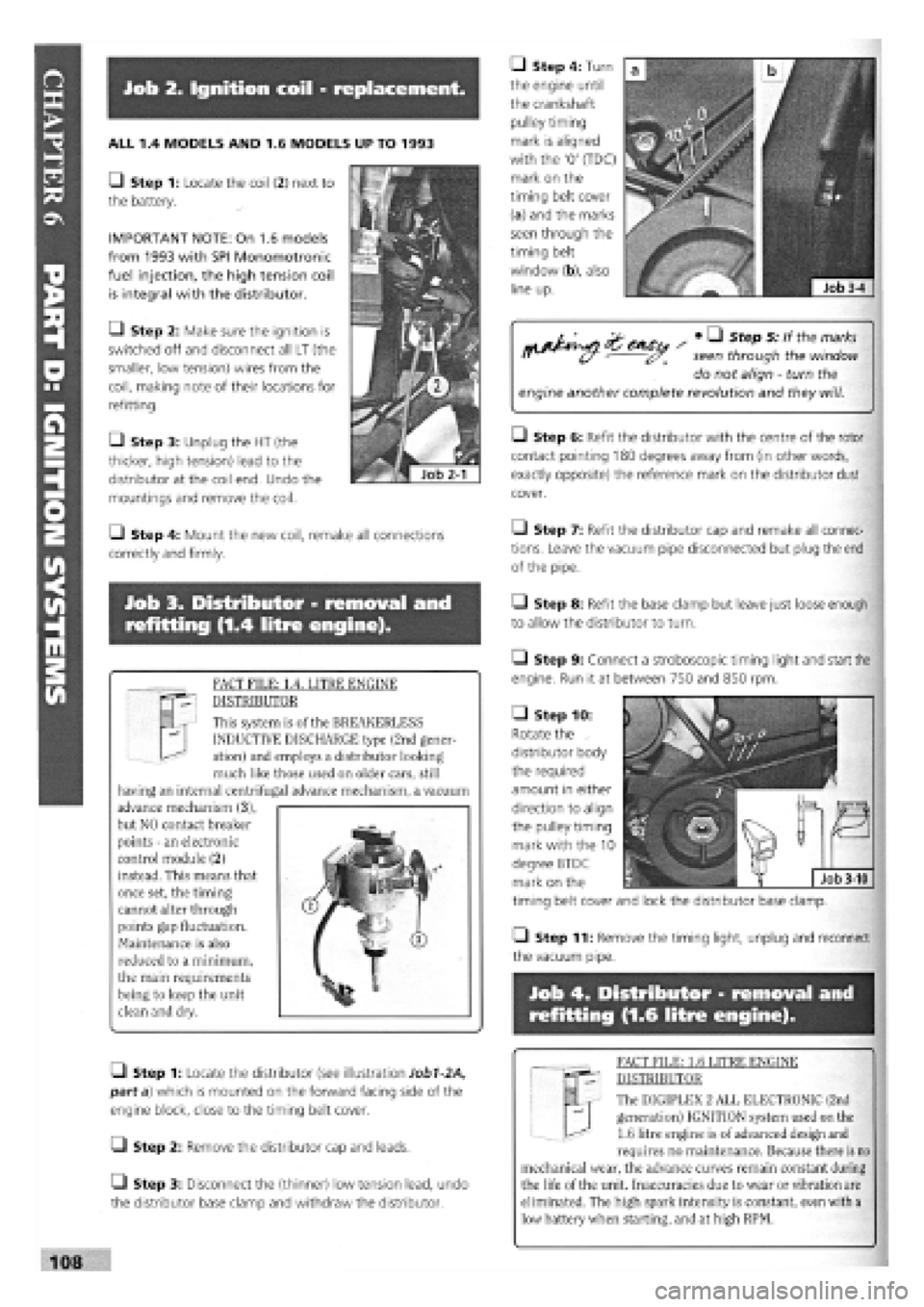
Job 2. Ignition coil - replacement.
ALL 1.4 MODELS AND 1.6 MODELS UP TO 1993
Q Step 1: Locate the coil (2) next to
the battery.
IMPORTANT NOTE: On 1.6 models
from 1993 with SPI Monomotronic
fuel injection, the high tension coil
is integral with the distributor.
• Step 2: Make sure the ignition is
switched off and disconnect all LT (the
smaller, low tension) wires from the
coil, making note of their locations for
refitting.
• Step 3: Unplug the HT (the
thicker, high tension) lead to the
distributor at the coil end. Undo the
mountings and remove the coil.
• Step 4: Mount the new coil, remake all connections
correctly and firmly.
Job 3. Distributor - removal and
refitting (1.4 litre engine).
FACT FILE: 1.4. LITRE ENGINE
DISTRIBUTOR
This system is of the BREAKERLESS
INDUCTIVE DISCHARGE type (2nd gener-
ation) and employs a distributor looking
much like those used on older cars, still
having an internal centrifugal advance mechanism, a vacuum
advance mechanism (3),
but NO contact breaker
points - an electronic
control module (2)
instead. This means that
once set, the timing
cannot alter through
points gap fluctuation.
Maintenance is also
reduced to a minimum,
the main requirements
being to keep the unit
clean and dry.
l_) Step 1: Locate the distributor (see illustration Job1-2A,
part a) which is mounted on the forward facing side of the
engine block, close to the timing belt cover.
I—] Step 2: Remove the distributor cap and leads.
Q Step 3: Disconnect the (thinner) low tension lead, undo
the distributor base clamp and withdraw the distributor.
Q Step 4: Turn
the engine until
the crankshaft
pulley timing
mark is aligned
with the '0' (TDC)
mark on the
timing belt cover
(a) and the marks
seen through the
timing belt
window (b), also
line up.
• Step S: If the
marks
seen through the window
do not align
-
turn the
engine another complete revolution and they will.
• Step 6: Refit the distributor with the centre of the rotor
contact pointing 180 degrees away from (in other words,
exactly opposite) the reference mark on the distributor dust
cover.
Q Step 7: Refit the distributor cap and remake all connec-
tions. Leave the vacuum pipe disconnected but plug the end
of the pipe.
Q Step 8: Refit the base clamp but leave just loose enough
to allow the distributor to turn.
Q Step 9: Connect a stroboscopic timing light and start the
engine. Run it at between 750 and 850 rpm.
• Step 10:
Rotate the
distributor body
the required
amount in either
direction to align
the pulley timing
mark with the 10
degree BTDC
mark on the
timing belt cover
• Step 11: Remove the timing light, unplug and reconnect
the vacuum pipe.
Job 4. Distributor - removal and
refitting (1.6 litre engine).
FACT FILE: 1.6 LITRE ENGINE
DISTRIBUTOR
The DIGIPLEX 2 ALL ELECTRONIC (2nd
generation) IGNITION system used on the
1.6 litre engine is of advanced design and
requires no maintenance. Because there is no
mechanical wear, the advance curves remain constant during
the life of the unit. Inaccuracies due to wear or vibration are
eliminated. The high spark intensity is constant, even with a
low battery when starting, and at high RPM.
and lock the distributor base clamp.
Page 105 of 171
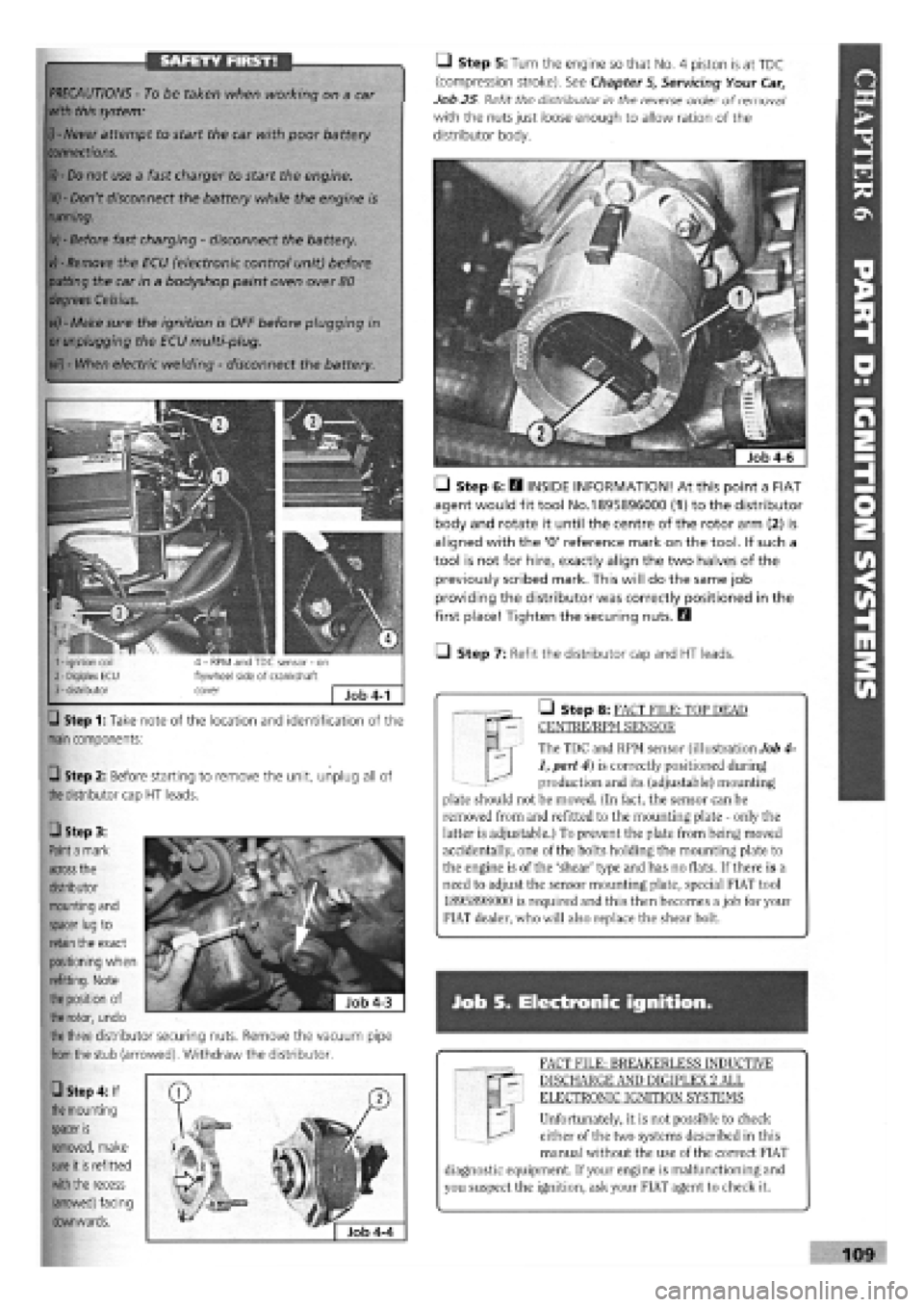
SAFETY FIRST!
Step 1: Take note of the location and identification of the
main
components:
Q Step 2: Before starting to remove the unit, unplug all of
the
distributor cap
HT
leads.
M | The TDC and RPM sensor (illustration Job 4-
1, part 4) is correctly positioned during
production and its (adjustable) mounting
plate should not be moved. (In fact, the sensor can be
removed from and refitted to the mounting plate - only the
latter is adjustable.) To prevent the plate from being moved
accidentally, one of the bolts holding the mounting plate to
the engine is of the 'shear' type and has no flats. If there is a
need to adjust the sensor mounting plate, special FIAT tool
1895898000 is required and this then becomes a job for your
FIAT dealer, who will also replace the shear bolt.
• Step 8: FACT FILE: TOP DEAD
CENTRE/RPM SENSOR
PRECAUTIONS -
To be taken when working on a car
with this system:
i) - Never
attempt to start the car with poor battery
connections.
ii) - Do
not use a fast charger to start the engine.
iii) -
Don't disconnect the battery while the engine is
running.
iv) -
Before fast charging
-
disconnect the battery.
vj - Remove
the ECU (electronic control unit) before
putting
the car in a bodyshop paint oven over
80
degrees Celsius.
vi) -
Make sure the ignition is OFF before plugging in
or unplugging
the ECU multi-plug.
vii) -
When electric welding
-
disconnect the battery.
Q Step 5: Turn the engine so that No. 4 piston is at TDC
(compression stroke). See Chapter
5,
Servicing Your Car,
Job 25 Refit the distributor in the reverse order of removal1
with the nuts just loose enough to allow ration of the
distributor body.
• Step 6: E3 INSIDE INFORMATION! At this point a FIAT
agent would fit tool No.1895896000 (1) to the distributor
body and rotate it until the centre of the rotor arm (2) is
aligned with the '0' reference mark on the tool. If such a
tool is not for hire, exactly align the two halves of the
previously scribed mark. This will do the same job
providing the distributor was correctly positioned in the
first place! Tighten the securing nuts. Q
• Step 7: Refit the distributor cap and HT leads.
Job S. Electronic ignition.
FACT FILE: BREAKERLESS INDUCTIVE
DISCHARGE AND DIGIPLEX 2 ALL
ELECTRONIC IGNITION SYSTEMS
Unfortunately, it is not possible to check
either of the two systems described in this
manual without the use of the correct FIAT
diagnostic equipment. If your engine is malfunctioning and
you suspect the ignition, ask your FIAT agent to check it.
109
• Step 3:
Paint a
mark
across
the
distributor
mounting and
spacer lug
to
retain
the exact
positioning when
refitting. Note
the position
of
the rotor,
undo
the three
distributor securing nuts. Remove the vacuum pipe
from the
stub (arrowed). Withdraw the distributor.
• Step 4: If
the
mounting
spacer
is
removed, make
sure
it
is
refitted
with the
recess
(arrowed) facing
downwards.
Page 106 of 171
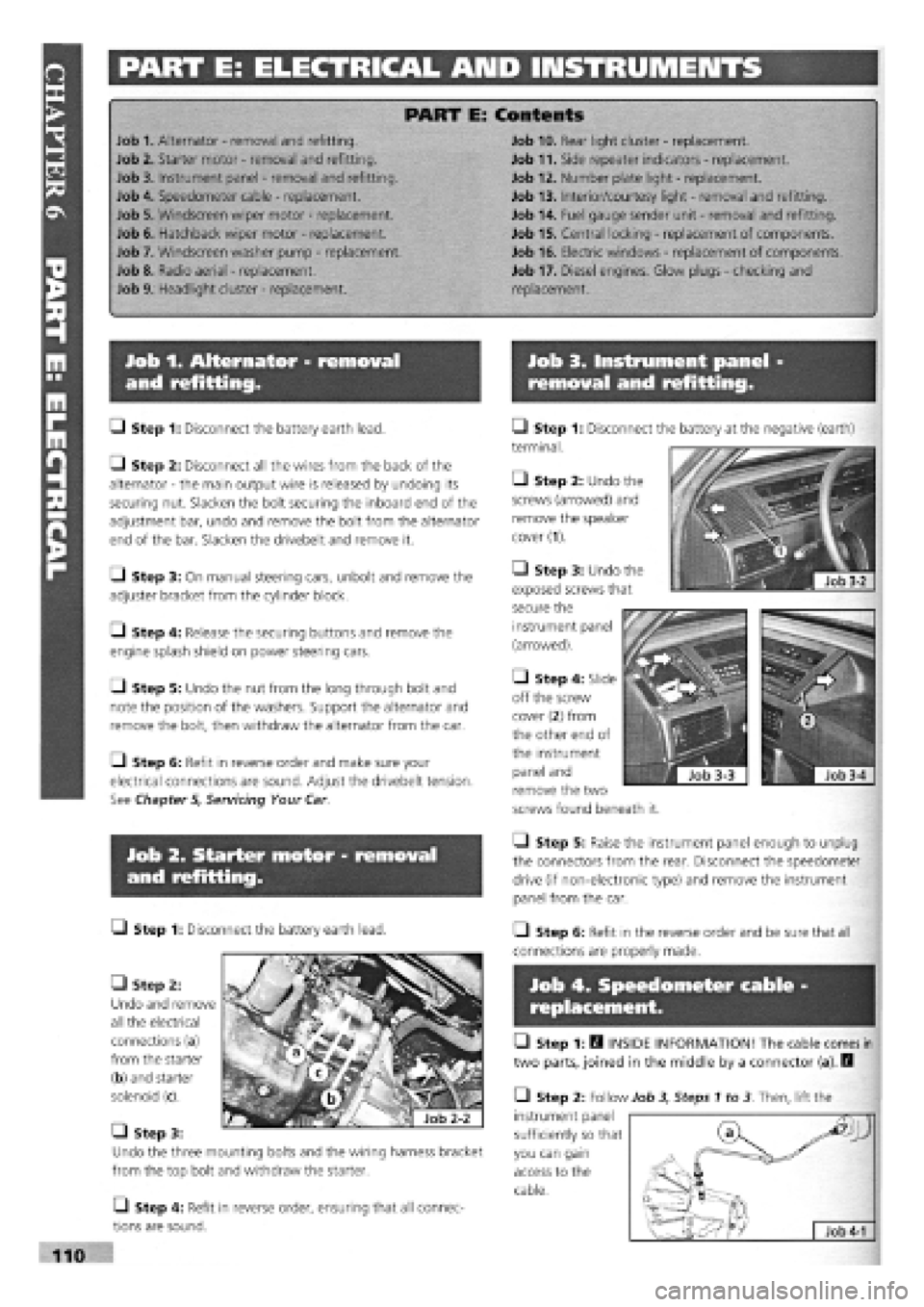
PART E: ELECTRICAL ARID INSTRUMENTS
PART E: Contents
Job 1. Alternator
-
removal and refitting. Job 10. Rear light cluster
-
replacement.
Job 2. Starter motor
-
removal and refitting. Job 11. Side repeater indicators
-
replacement.
Job 3. Instrument panel
-
removal and refitting. Job 12. Number plate light
-
replacement.
Job 4. Speedometer cable
-
replacement. Job 13. Interior/courtesy light
-
removal and refitting.
Job 5. Windscreen wiper motor
-
replacement. Job 14. Fuel gauge sender unit
-
removal and refitting.
Job 6. Hatchback wiper motor
-
replacement. Job 15. Central locking
-
replacement of components.
Job 7. Windscreen washer pump
-
replacement. Job 16. Electric windows
-
replacement of components.
Job 8. Radio aerial
-
replacement. Job 17. Diesel engines. Glow plugs
-
checking and
Job 9. Headlight cluster
-
replacement. replacement.
Job 1. Alternator - removal
and refitting.
Job 3. Instrument panel -
removal and refitting.
• Step 1: Disconnect the battery earth lead.
Q Step 2: Disconnect all the wires from the back of the
alternator
-
the main output wire is released by undoing its
securing nut. Slacken the bolt securing the inboard end of the
adjustment bar, undo and remove the bolt from the alternator
end of the bar. Slacken the drivebelt and remove it.
Q Step 3: On manual steering cars, unbolt and remove the
adjuster bracket from the cylinder block.
Q Step 4: Release the securing buttons and remove the
engine splash shield on power steering cars.
Q Step 5: Undo the nut from the long through bolt and
note the position of the washers. Support the alternator and
remove the bolt, then withdraw the alternator from the car.
Q Step 6: Refit in reverse order and make sure your
electrical connections are sound. Adjust the drivebelt tension.
See Chapter 5, Servicing Your Car
• Step 1: Disconnect
terminal.
• Step 2: Undo the
screws (arrowed) and
remove the speaker
cover (1).
Job 2. Starter motor - removal
and refitting.
• Step 1: Disconnect the battery earth lead.
• Step 2:
Undo and remove
all the electrical
connections (a)
from the starter
(b) and starter
solenoid (c).
Q Step 4: Refit in reverse order, ensuring that all connec-
tions are sound.
Q Step 5: Raise the instrument panel enough to unplug
the connectors from the rear. Disconnect the speedometer
drive (if non-electronic type) and remove the instrument
panel from the car.
Q Step 6: Refit in the reverse order and be sure that all
connections are properly made.
Job 4. Speedometer cable
replacement.
• Step 1: H INSIDE INFORMATION! The cable comes in
two parts, joined in the middle by a connector (a). Q
• Step 2: Follow Job 3, Steps 1 to 3 Then, lift the
instrument panel
sufficiently so that
you can gain
access to the
cable.
^Jj
Job
4-1
the battery at the negative (earth)
• Step 3: Undo the
exposed screws that
secure the
instrument panel
(arrowed).
• Step 4: Slide
off the screw
cover
(2)
from
the other end of
the instrument
panel and
remove the two
screws found beneath it.
• Step 3:
Undo the three mounting bolts and the wiring harness bracket
from the top bolt and withdraw the starter.
Page 107 of 171
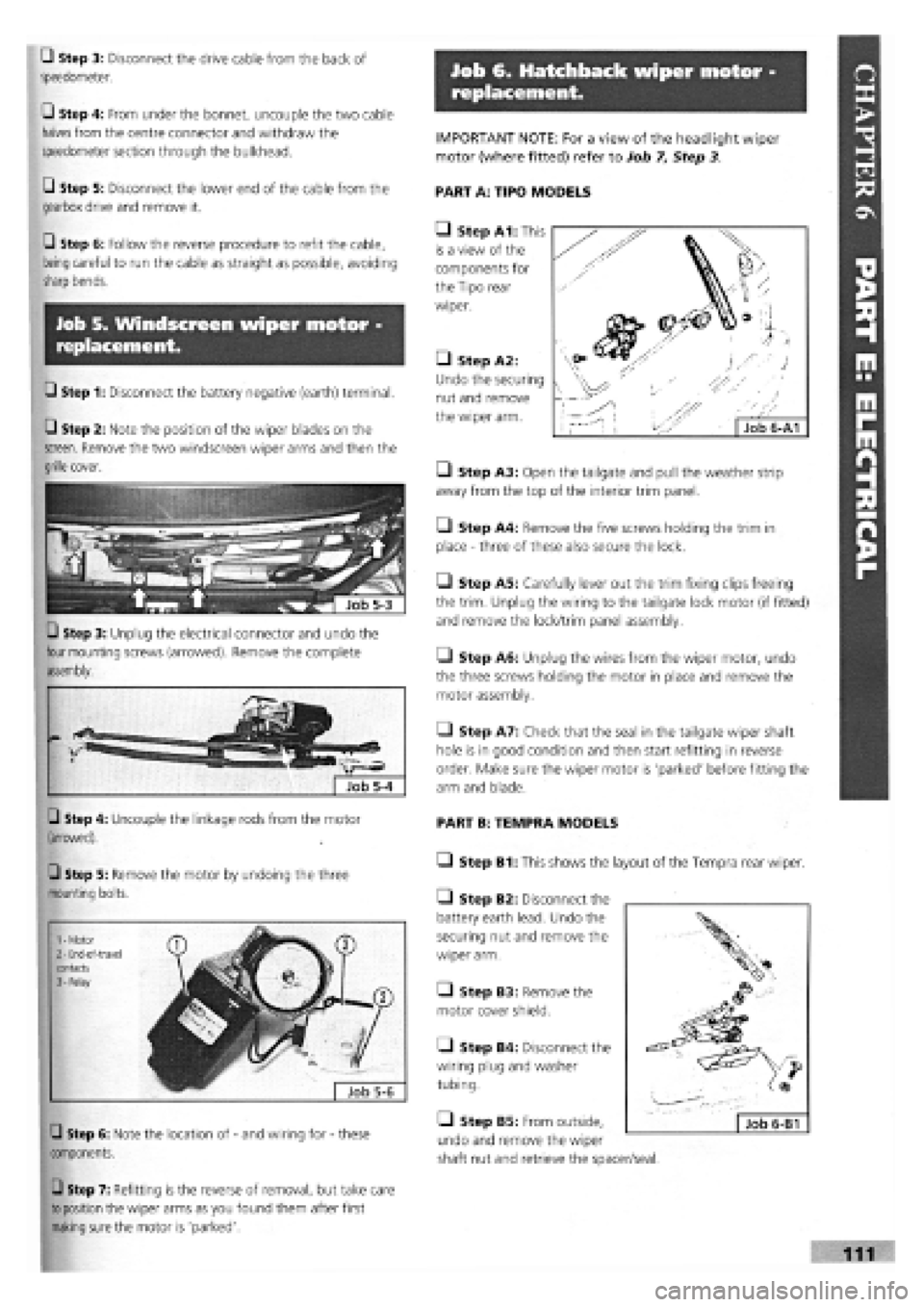
Job 6. Hatchback wiper motor -
replacement.
• Step 3: Disconnect the drive cable from the back of
speedometer.
• Step 4: From under the bonnet, uncouple the two cable
halves
from the centre connector and withdraw the
speedometer section through the bulkhead.
Q Step 5: Disconnect the lower end of the cable from the
gearbox drive and remove it.
G Step 6: Follow the reverse procedure to refit the cable,
being
careful to run the cable as straight as possible, avoiding
sharp bends.
Job 5. Windscreen wiper motor -
replacement.
Q Step 1: Disconnect the battery negative (earth) terminal.
Q Step 2: Note the position of the wiper blades on the
screen. Remove the two windscreen wiper arms and then the
grille
cover.
Q Step 3: Unplug the electrical connector and undo the
four mounting screws (arrowed). Remove the complete
assembly.
Q Step 4: Uncouple the linkage rods from the motor
(arrowed).
Q Step 5: Remove the motor by undoing the three
mounting bolts.
Q Step 6: Note the location of
-
and wiring for
-
these
components.
Q Step 7: Refitting is the reverse of removal, but take care
to position
the wiper arms as you found them after first
making
sure the motor is 'parked'.
IMPORTANT NOTE: For a view of the headlight wiper
motor (where fitted) refer to Job 7. Step 3.
PART A: TIPO MODELS
• Step A1: This
is a view of the
components for
the Tipo rear
wiper.
• Step A2:
Undo the securing
nut and remove
the wiper arm.
• Step A3: Open the tailgate and pull the weather strip
away from the top of the interior trim panel.
• Step A4: Remove the five screws holding the trim in
place
-
three of these also secure the lock.
Q Step A5: Carefully lever out the trim fixing clips freeing
the trim. Unplug the wiring to the tailgate lock motor (if fitted)
and remove the lock/trim panel assembly.
• Step A6: Unplug the wires from the wiper motor, undo
the three screws holding the motor in place and remove the
motor assembly.
• Step A7: Check that the seal in the tailgate wiper shaft
hole is in good condition and then start refitting in reverse
order. Make sure the wiper motor is 'parked' before fitting the
arm and blade.
PART B: TEMPRA MODELS
• Step B1: This shows the layout of the Tempra rear wiper.
Q Step B2: Disconnect the
battery earth lead. Undo the
securing nut and remove the
wiper arm.
Q Step B3: Remove the
motor cover shield.
Q Step B4: Disconnect the
wiring plug and washer
tubing.
• Step B5: From outside,
undo and remove the wiper
shaft nut and retrieve the spacer/seal.
Page 108 of 171
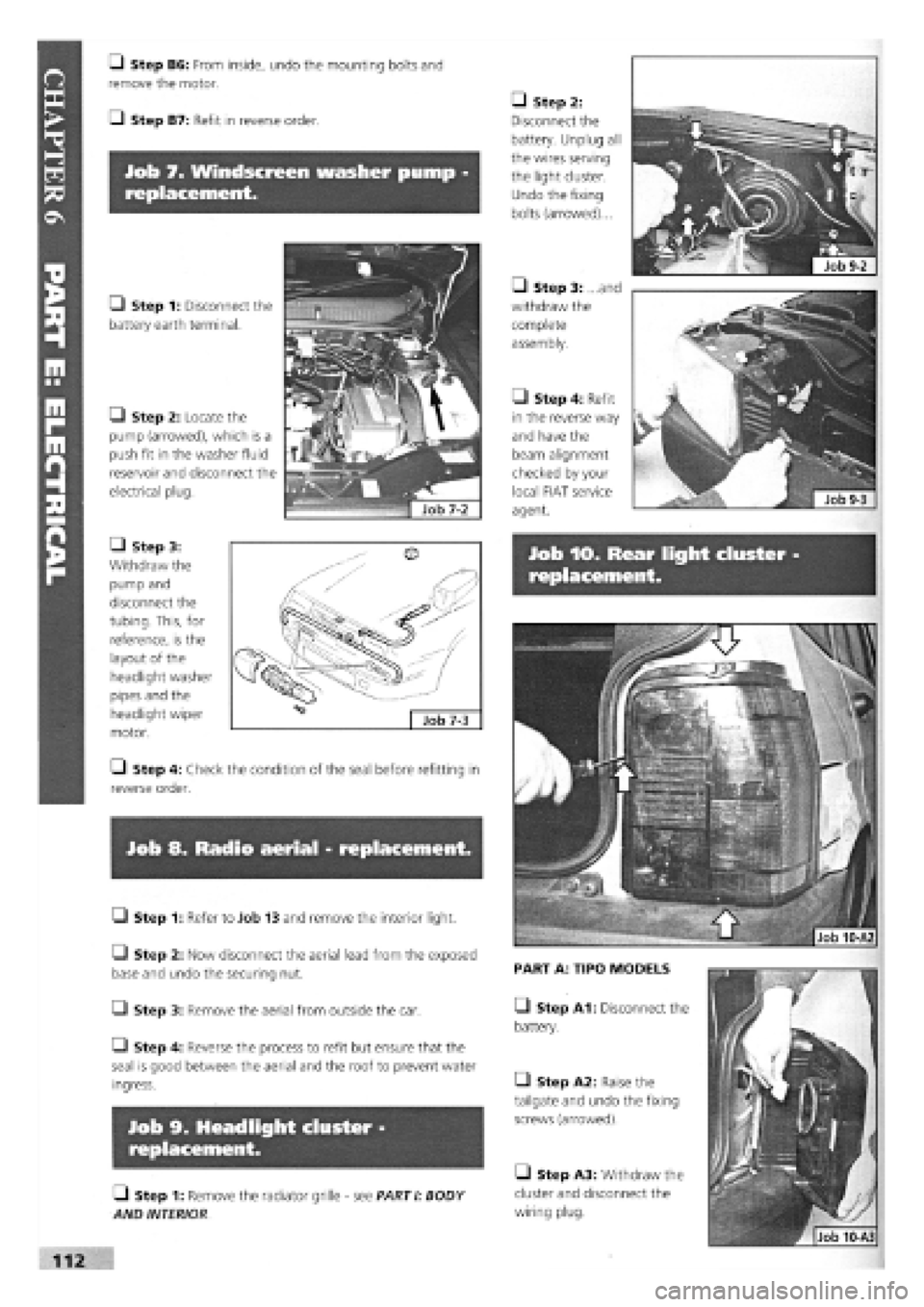
Job
9-2
Job 7. Windscreen washer pump -
replacement.
Job 10. Rear light cluster
replacement.
Job 8. Radio aerial - replacement.
• Step 1: Refer to Job 13 and remove the interior light.
Q Step 2: Now disconnect the aerial lead from the exposed
base and undo the securing nut.
• Step 3: Remove the aerial from outside the car.
Q Step 4: Reverse the process to refit but ensure that the
seal is good between the aerial and the roof to prevent water
ingress.
Job 9. Headlight cluster -
replacement.
• Step 1: Remove the radiator grille
-
see PARTI: BODY
AND INTERIOR
PART A: TIPO MODELS
O Step A1: Disconnect the
battery.
• Step A2: Raise the
tailgate and undo the fixing
screws (arrowed).
• Step A3: Withdraw the
cluster and disconnect the
wiring plug.
• Step 2:
Disconnect the
battery. Unplug all
the wires serving
the light cluster.
Undo the fixing
bolts (arrowed)...
• Step 3: ...and
withdraw the
complete
assembly.
Q Step B6: From inside, undo the mounting bolts and
remove the motor.
Q Step B7: Refit in reverse order.
O Step 1: Disconnect the
battery earth terminal.
• Step 2: Locate the
pump (arrowed), which is a
push fit in the washer fluid
reservoir and disconnect the
electrical plug.
• Step 4: Refit
in the reverse way
and have the
beam alignment
checked by your
local FIAT service
agent.
• Step 3:
Withdraw the
pump and
disconnect the
tubing. This, for
reference, is the
layout of the
headlight washer
pipes and the
headlight wiper
motor.
• Step 4: Check the condition of the seal before refitting in
reverse order.
Page 109 of 171
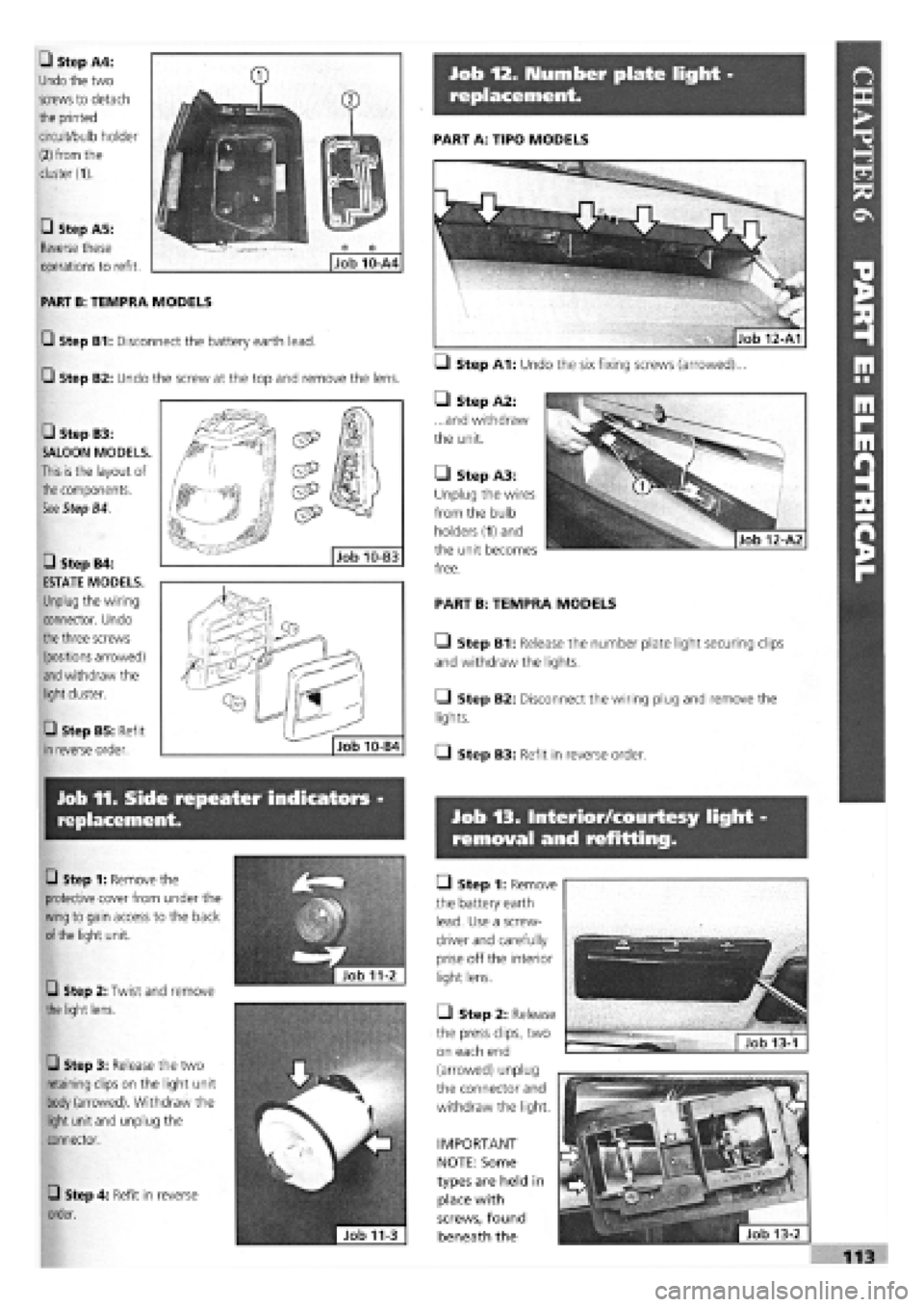
Job 12. Number plate light -
replacement.
lob 11. Side repeater indicators -
replacement. Job 13. Interior/courtesy light -
removal and refitting.
Job 11-2 |
G Step 1: Remove the
protective cover from under the
wing
to gain access to the back
of the
light unit.
G Step 2: Twist and remove
the
light lens.
G Step 3: Release the two
retaining clips on the light unit
body (arrowed). Withdraw the
light unit and unplug the
connector.
G Step 4: Refit in reverse
order.
PART A: TIPO MODELS
G Step A4:
Undo the two
screws to detach
the printed
circuit/bulb holder
(2) from
the
cluster (1).
G Step A5:
Reverse these
operations to refit.
PART B: TEMPRA MODELS
G Step B1: Disconnect the battery earth lead.
G Step B2: Undo the screw at the top and remove the lens.
IMPORTANT
NOTE: Some
types are held in
place with
screws, found
beneath the
G Step B3:
SALOON MODELS.
This is
the layout of
the
components.
See
Step B4.
G Step B4:
ESTATE MODELS.
Unplug the wiring
connector. Undo
the
three screws
(positions arrowed)
and
withdraw the
light
cluster.
G Step B5: Refit
in
reverse order.
Q Step 1: Remove
the battery earth
lead. Use a screw-
driver and carefully
prise off the interior
light lens.
Job 10-B3
Job 10-B4
• Step A1: Undo the six fixing screws (arrowed)...
• Step A3:
Unplug the wires
from the bulb
holders
(1)
and
the unit becomes
free.
PART B: TEMPRA MODELS
• Step B1: Release the number plate light securing clips
and withdraw the lights.
IG Step B2: Disconnect the wiring plug and remove the
lights.
O Step B3: Refit in reverse order.
• Step A2:
...and withdraw
the unit.
Job 10-A4
• Step 2: Release
the press clips, two
on each end
(arrowed) unplug
the connector and
withdraw the light.
Page 110 of 171
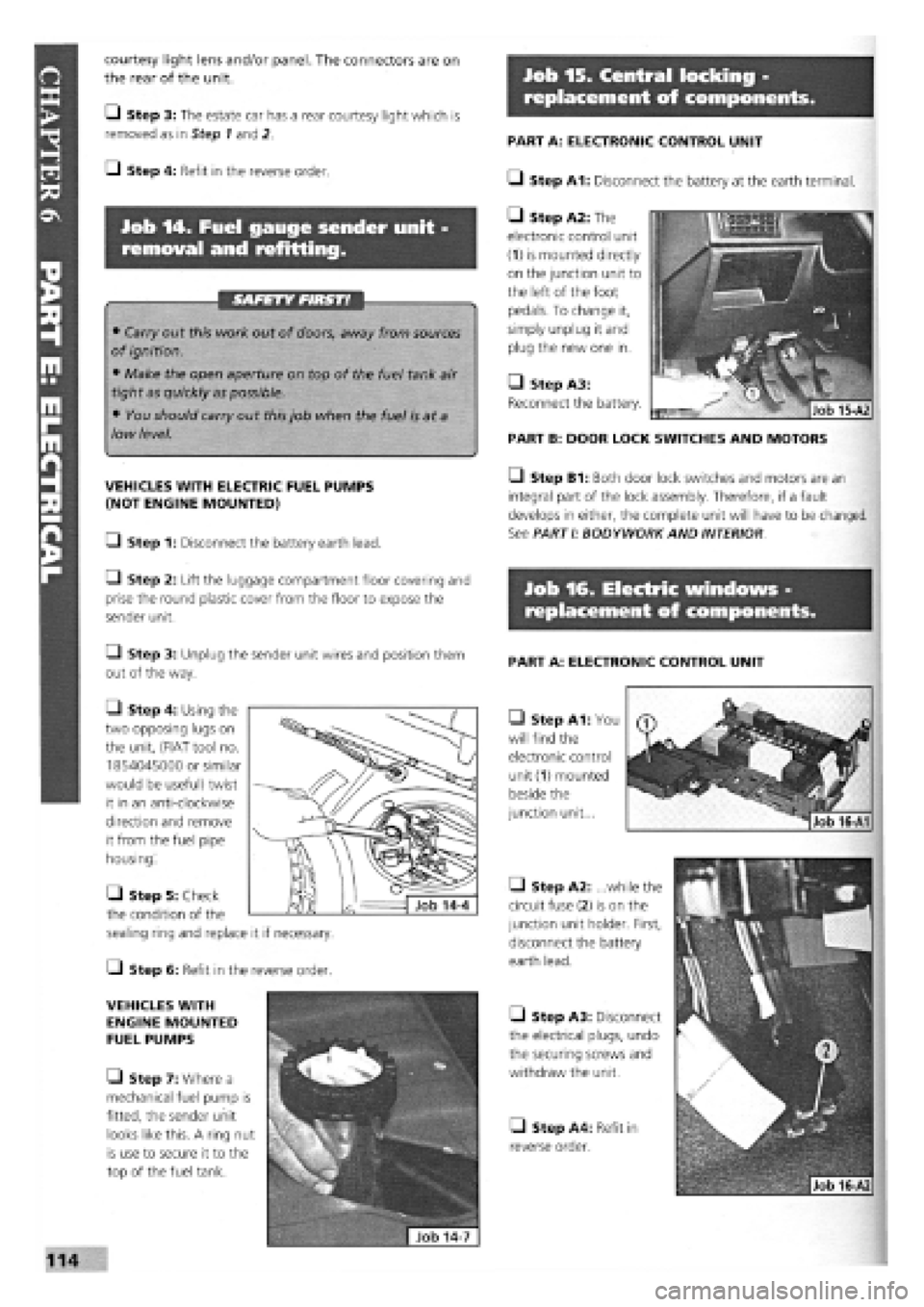
Job 15. Central locking -
replacement off components.
Job 14. Fuel gauge sender unit
removal and refitting.
SAFETY FIRST!
• Carry out this work out of doors, away from sources
of ignition.
• Make the open aperture on top of the fuel tank air
tight as quickly as possible.
• You should carry out this job when the fuel is at a
low level.
VEHICLES WITH ELECTRIC FUEL PUMPS
(NOT ENGINE MOUNTED)
Job 16. Electric windows -
replacement of components.
courtesy light lens and/or panel. The connectors are on
the rear of the unit.
• Step 3: The estate car has a rear courtesy light which is
removed as in Step 1 and 2
LJ Step 4: Refit in the reverse order.
PART A: ELECTRONIC CONTROL UNIT
• Step A1: You
will find the
electronic control
unit
(1)
mounted
beside the
junction unit...
PART A: ELECTRONIC CONTROL UNIT
• Step A1: Disconnect the battery at the earth terminal.
• Step A2: The
electronic control unit
(1) is mounted directly
on the junction unit to
the left of the foot
pedals. To change it,
simply unplug it and
plug the new one in.
• Step A3:
Reconnect the battery.
PART B: DOOR LOCK SWITCHES AND MOTORS
• Step B1: Both door lock switches and motors are an
integral part of the lock assembly. Therefore, if a fault
develops in either, the complete unit will have to be changed.
See PARTI: BODYWORK AND INTERIOR
• Step A2: ...while the
circuit fuse (2) is on the
junction unit holder. First,
disconnect the battery
earth lead.
• Step A3: Disconnect
the electrical plugs, undo
the securing screws and
withdraw the unit.
• Step A4: Refit in
reverse order.
Q Step 1: Disconnect the battery earth lead.
Q Step 2: Lift the luggage compartment floor covering and
prise the round plastic cover from the floor to expose the
sender unit.
Q Step 3: Unplug the sender unit wires and position them
out of the way.
• Step 4: Using the
two opposing lugs on
the unit, (FIAT tool no.
1854045000 or similar
would be useful) twist
it in an anti-clockwise
direction and remove
it from the fuel pipe
housing.
C-) Step 6: Refit in the reverse order.
VEHICLES WITH
ENGINE MOUNTED
FUEL PUMPS
• Step 7: Where a
mechanical fuel pump is
fitted, the sender unit
looks like this. A ring nut
is use to secure it to the
top of the fuel tank.
• Step 5: Check
the condition of the
sealing ring and replace it if necessary.
Job 16-A1